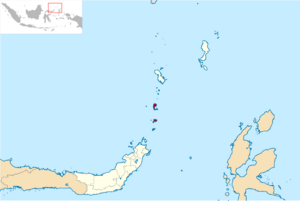Siau Island tarsier facts for kids
Quick facts for kids Siau Island tarsier |
|
|---|---|
 |
|
| Conservation status | |
| Scientific classification | |
| Genus: |
Tarsius
|
| Species: |
tumpara
|
 |
|
The Siau Island tarsier (Tarsius tumpara) is a small primate that lives on the tiny volcanic Siau Island in Indonesia. These amazing animals are part of a family called "Tarsiidae," which includes 14 different types of tarsiers. They are known for their incredibly large eyes, which are so big they can't move in their sockets! Their eyes are almost as big as their brain.
Locally, people on Siau Island call these tarsiers Tumpara. This name comes from the Siau dialect of the Sangir language. In other nearby areas, like Sangir Island, tarsiers have different names, such as Senggasi or Higo.
Contents
About the Siau Island Tarsier
What They Look Like
The Siau Island tarsier has some special features. They have white fur on their bellies. Unlike some of their relatives, they don't have golden fur on their backs. They also have a larger skull compared to other tarsier species.
These tarsiers are quite small, measuring about 4 to 6 inches (10–15 cm) long. Their long tails can add another 8 inches (20 cm) to their total length. They weigh between 100 and 150 grams, which is about the same as a small apple. This light weight helps them move quietly when they jump through trees.
Amazing Eyes
The Siau Island tarsier's eyes are truly remarkable. They are very large and don't move. Their irises, the colored part of the eye, can be gold or brown. These big eyes help them see very well at night, which is important because they are active after dark. They have special vision that helps them see things sharply.
How They Move
Siau Island tarsiers are arboreal, meaning they live mostly in trees. They are excellent jumpers and climbers. They can leap up to 10 feet (3 meters) high! They also have a neck that can turn 180 degrees, helping them look around without moving their bodies. Their long, thin fingers are perfect for grabbing branches and catching prey. When hunting, a T. tumpara will often sit quietly on a branch, waiting for an animal to come close before it attacks.
What They Eat
These tarsiers are carnivores, which means they eat meat. Their diet mainly consists of insects like spiders. They also hunt small animals such as frogs, lizards, and small birds. They have a wide mouth, strong jaws, and sharp teeth to help them catch and eat their prey.
Reproduction and Life Cycle
Siau Island tarsiers can start having babies when they are about two years old. A mother tarsier is pregnant for about six months. After this time, she gives birth to one baby at a time.
Where They Live
Tarsiers are found in Southeast Asia. The T. tumpara species lives only on Siau Island, Indonesia. Scientists have studied their habitat and found that they live in a small area of about 19.4 square kilometers. The number of tumpara tarsiers is decreasing because of various threats they face.
Their Home in the Trees
Siau Island tarsiers are nocturnal, meaning they are active at night. During the day, they sleep in tree holes, especially in fig trees. They usually go to sleep between 5:00 AM and 6:00 AM. Each tarsier in a group often sleeps in its own tree. This helps protect the whole family if a predator tries to attack.
Conservation Efforts
The Siau Island tarsier is considered a critically endangered animal. This means they are at a very high risk of disappearing forever. The IUCN (International Union for Conservation of Nature) has even put them on a list of "The World's 25 Most Endangered Primates."
There are several reasons why these tarsiers are in danger. People sometimes hunt them for their meat or to use in traditional medicine. They are also sometimes caught and sold as pets. Their home is also at risk because it's not a protected area. This means their habitat can be lost if no one steps in to help. The island also has a large human population, which means less space for the tarsiers. Volcanic activity on the island also adds to the threats. Because of all these problems, the number of tumpara tarsiers has dropped by more than 25% in the last 25 years.
Who Hunts Them
The main predators of the Siau Island tarsier are humans, tree snakes, lizards, birds of prey, and feral cats. However, tarsiers are very good at hiding, which makes it hard for predators to catch them.
Images for kids





